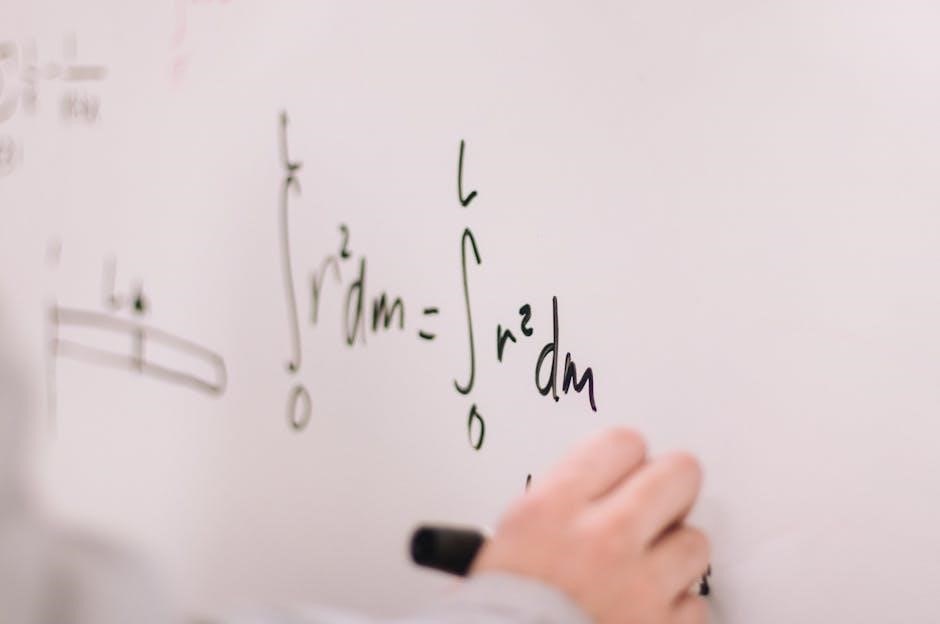Mastering equations and inequalities is essential for algebraic proficiency. Worksheets offer structured practice, enhancing problem-solving skills and preparing students for real-world applications through various exercises.
1.1 Importance of Equations and Inequalities in Mathematics
Equations and inequalities are fundamental in mathematics, forming the backbone of algebra and problem-solving. They enable the representation of relationships between variables, aiding in modeling real-world scenarios. Solving these mathematical expressions is crucial for various fields, including engineering, economics, and science. Proficiency in equations and inequalities enhances critical thinking and logical reasoning, while worksheets provide structured practice, ensuring mastery. These tools are indispensable for developing analytical skills, making them vital for academic and professional success. Regular practice with worksheets fosters a deeper understanding of mathematical concepts.
1.2 Brief Overview of Worksheets and Their Benefits
Worksheets are invaluable tools for practicing and mastering equations and inequalities. They provide a structured format with a variety of problems, allowing students to apply theoretical knowledge. Many worksheets, such as those in PDF format, include answer keys, enabling self-assessment and immediate feedback. These resources cater to different learning needs, offering exercises tailored to various skill levels. They also promote consistency and repetition, which are key to building confidence and fluency in problem-solving. Additionally, worksheets are easily accessible and customizable, making them a flexible learning aid for students and educators alike.

Types of Equations
Equations vary in complexity, including one-step, two-step, and multi-step problems. They can also feature variables on both sides, requiring advanced strategies for solving.
2.1 One-Step Equations
One-step equations are the simplest form, involving a single operation to isolate the variable. Examples include equations like x + 3 = 7 or y ⎯ 2 = 5. These require basic operations such as addition, subtraction, multiplication, or division to solve. They are foundational for building algebraic skills and appear frequently in worksheets. Practice worksheets with answers are widely available, offering exercises that range from basic to slightly complex one-step problems, ensuring mastery before progressing to multi-step equations.
2.2 Two-Step Equations
Two-step equations require two operations to solve for the variable. For example, in 2x + 3 = 7, first subtract 3 from both sides, then divide by 2. These equations help build algebraic reasoning and are commonly found in worksheets with answers. They involve operations like addition/subtraction followed by multiplication/division or vice versa. Worksheets often provide practice problems, ensuring students master this foundational skill before advancing to more complex equations. Regular practice with such problems enhances problem-solving speed and accuracy.
2.3 Multi-Step Equations
Multi-step equations involve several operations to isolate the variable. For instance, solving 3(2x ─ 4) = 12 requires distributing, combining like terms, and then dividing. These equations challenge students to apply multiple algebraic principles in sequence. Worksheets with answers provide comprehensive practice, covering various scenarios. They help students develop systematic approaches and ensure a strong grasp of equation solving. Regular practice with multi-step equations builds confidence and prepares students for more advanced algebraic problems.
2.4 Equations with Variables on Both Sides
Equations with variables on both sides require careful manipulation to isolate the variable. For example, solving 2x + 3 = x + 5 involves subtracting x from both sides and then subtracting 3. The goal is to simplify the equation to find the value of the variable. These problems test the ability to apply inverse operations and maintain balance in the equation. Worksheets with answers provide ample practice, helping students master techniques for handling variables on both sides and ensuring accurate solutions. Regular practice builds confidence and algebraic fluency.

Types of Inequalities
Inequalities are categorized into basic linear, compound, absolute value, and quadratic types. Each requires distinct strategies for solving, ensuring accurate and efficient problem resolution.
3.1 Basic Linear Inequalities
Basic linear inequalities involve a single variable and simple expressions, such as ( x > 5 ) or ( x < 10 ). These inequalities are foundational, focusing on direct comparisons between expressions. Worksheets often include problems like solving for ( x ) in ( x + 3 > 7 ) or ( x ─ 2 < 4 ). They require understanding inequality direction and performing inverse operations. Examples from resources like Kuta Software and Mashup Math highlight these concepts, providing clear practice for mastering basic inequality solving skills.
3.2 Compound Inequalities
Compound inequalities involve two or more conditions combined using “and” or “or.” Examples include x > 3 and x < 7 or x < -2 or x > 5. These inequalities require understanding how to interpret and graph multiple conditions. Worksheets often feature problems like solving 5 < x + 3 < 9 or x ⎯ 4 < -1 or x + 2 > 6. Resources like Kuta Software provide exercises that emphasize graphing solutions on number lines, ensuring clarity in identifying valid ranges for variables.
3.3 Absolute Value Inequalities
Absolute value inequalities involve expressions like |x ─ a| < b or |x ⎯ a| > b. These inequalities have two cases: one where the expression inside is positive and one where it is negative. For example, |2x ─ 5| < 3 translates to -3 < 2x ─ 5 < 3, while |x/3 + 4| > 2 becomes x/3 + 4 < -2 or x/3 + 4 > 2. Worksheets often provide exercises where students solve and graph these inequalities, reinforcing their understanding of absolute value properties.
3.4 Quadratic Inequalities
Quadratic inequalities involve expressions with squared variables, such as ax² + bx + c < 0 or ax² + bx + c > 0. To solve them, find the roots of the corresponding equation ax² + bx + c = 0, then determine the intervals where the quadratic expression is positive or negative. Graphing helps visualize these intervals. For example, if a parabola opens upwards and crosses the x-axis at x = 2 and x = 5, the expression is negative between these roots. Worksheets often include exercises where students solve, graph, and provide interval solutions for quadratic inequalities, enhancing their algebraic skills.

Solving Equations: Step-by-Step Guide
Solving equations involves simplifying expressions, combining like terms, and isolating the variable using operations like addition, subtraction, multiplication, or division. Always check solutions by substitution.
4.1 Adding or Subtracting to Isolate the Variable
Begin by eliminating constants on the variable’s side using addition or subtraction. For instance, in 3x + 5 = 11, subtract 5 from both sides to isolate the term with x. This step ensures the equation remains balanced, maintaining equality. Always perform the same operation on both sides to avoid altering the equation’s solution. Practice worksheets with answers provide exercises to master this fundamental skill, essential for solving more complex equations.
4.2 Multiplying or Dividing to Solve for the Variable
After isolating the variable term, solve for the variable by multiplying or dividing both sides by the coefficient. For example, in 2x = 10, divide both sides by 2 to find x = 5. Always apply the same operation to both sides to maintain balance. Be cautious with negative coefficients and division, as signs can change. Worksheets with answers provide ample practice for mastering these operations, ensuring accuracy in solving linear equations and inequalities effectively. Regular practice enhances fluency in algebraic manipulation.
4.3 Combining Like Terms
Combining like terms simplifies equations by adding or subtracting coefficients of the same variable. For example, 3x + 2x = 5x and 5a ⎯ 2a = 3a. This step is crucial before isolating the variable. Ensure terms are identical in variable and exponent. Worksheets with answers provide exercises to practice identifying and combining like terms accurately. Regular practice helps students recognize and simplify expressions efficiently, improving their algebraic manipulation skills and problem-solving speed. Mastering this step is foundational for solving complex equations and inequalities effectively.
4.4 Checking Solutions
Checking solutions ensures accuracy by verifying if the answer satisfies the original equation or inequality. Substitute the solution back into the equation to confirm equality. For inequalities, ensure the solution makes the statement true. Worksheets with answers provide a quick way to validate results. Regular checking helps identify mistakes early, reinforcing understanding and building confidence. This step is vital for mastering algebraic problem-solving and ensuring the reliability of solutions in both equations and inequalities.

Solving Inequalities: Step-by-Step Guide
Solving inequalities involves understanding direction, performing operations, and graphing solutions. Start by isolating the variable, then adjust the inequality sign when multiplying/dividing by negatives. Compound inequalities require splitting or combining ranges, while absolute values need considering both positive and negative scenarios. Always verify solutions by substituting back into the original inequality to ensure validity.
5.1 Understanding Inequality Direction
Grasping inequality direction is crucial for accurate solutions. The inequality sign (<, >, ≤, ≥) indicates the relationship between expressions. When multiplying or dividing by a negative number, the inequality sign must be reversed to maintain the correct relationship. For example, if you have 4x > -12, dividing both sides by 4 gives x > -3. Reversing the sign ensures the solution set remains valid. This fundamental rule applies to all inequality operations, making it essential for solving both simple and complex inequalities effectively.
5.2 Performing Operations on Both Sides
When solving inequalities, it’s essential to perform the same operation on both sides to maintain balance. For example, if you add or subtract a number from one side, do the same to the other. Similarly, when multiplying or dividing by a non-zero number, apply the operation equally. However, remember that dividing or multiplying by a negative number reverses the inequality sign. This rule ensures the inequality’s direction remains correct. Always check your solution by substituting it back into the original inequality to confirm its validity.
5.3 Solving Compound Inequalities
Compound inequalities involve two or more inequalities combined with “and” or “or.” For example, solving -3 ≤ x < 5 requires finding values of x that satisfy both parts. To solve, break the compound inequality into separate inequalities and solve each part. For "and" conditions, find the overlap in solutions, while "or" conditions combine the ranges. Always check if the solution set is valid by substituting values back into the original inequality. Practice worksheets help master these skills effectively.
5.4 Graphing Solutions on a Number Line
Graphing solutions on a number line provides a visual representation of inequality results. For example, x ≤ 4 is shown by shading all numbers to the left of 4, with a closed circle at 4. For x > 3, an open circle at 3 and shading to the right indicates the solution. Compound inequalities, like -2 ≤ x < 5, are graphed by shading between -2 and 5, using closed and open circles respectively. This method helps students interpret and verify solutions effectively, especially when combined with practice worksheets.

Common Mistakes to Avoid
Common mistakes include forgetting to reverse the inequality sign when multiplying/dividing by negatives, incorrectly distributing terms, and neglecting to check solutions, which can lead to errors.
6.1 Forgetting to Reverse the Inequality Sign
One of the most frequent errors occurs when multiplying or dividing both sides of an inequality by a negative number. Forgetting to reverse the inequality sign can lead to incorrect solutions. For example, if solving -2x > 4, students often incorrectly write x > -2 instead of x < -2. This mistake can drastically alter the solution set. Emphasizing this rule and practicing with various problems helps build awareness and reduces errors. Always remind students to "flip the sign" when dealing with negatives to ensure accurate results.
6.2 Incorrectly Distributing or Combining Terms
A common mistake involves incorrectly distributing terms or combining like terms. For example, students might add instead of subtract or mishandle negative signs. This often leads to incorrect solutions. Emphasize the importance of carefully applying operations to all terms within parentheses and ensuring signs are correctly handled. Practicing with worksheets helps identify such errors. Remind students to double-check their work, especially when dealing with negative coefficients or complex expressions, to avoid invalid solutions and strengthen their algebraic foundation.
6.3 Not Checking Solutions
One of the most frequent errors is failing to verify solutions after solving equations or inequalities. Students often assume their answers are correct without substituting them back into the original problem. This oversight can lead to undetected mistakes, especially with complex expressions. Encourage the habit of checking solutions to ensure accuracy. Worksheets with answer keys provide an excellent way for students to validate their work independently. Regular verification helps build confidence and reinforces the understanding of algebraic principles, making it a crucial step in the learning process.

Graphical Interpretation of Solutions
Graphical methods provide visual insights into equation and inequality solutions. Number lines and sign charts help students understand solution sets intuitively, making abstract concepts more concrete and accessible for learning.
7.1 Number Line Representation
A number line is a powerful tool for visualizing solutions to inequalities. By plotting solution ranges, students can easily interpret “less than,” “greater than,” or “between” scenarios. For example, x > 4 is shown by shading to the right of 4, while x < -2 shades to the left of -2. Closed circles indicate inclusion of endpoints, and open circles exclude them. This method helps students grasp inequality relationships and solution sets intuitively, enhancing their understanding of algebraic concepts through visual representation.
7.2 Sign Charts for Quadratic Inequalities
Sign charts are a valuable tool for solving quadratic inequalities. They help identify intervals where the quadratic expression is positive or negative. To create a sign chart, first find the roots of the quadratic equation, which divide the number line into intervals. Test each interval to determine the sign of the expression. If the parabola opens upward, the expression is positive outside the roots; if downward, it’s negative outside. This method simplifies solving inequalities by avoiding graphing, ensuring efficient and accurate solutions. Regular practice enhances proficiency in interpreting these charts.

Real-World Applications
Equations and inequalities are crucial in budgeting, distance-speed problems, and temperature measurements, providing practical tools for decision-making and problem-solving in everyday scenarios and professional fields alike.
8.1 Budgeting and Financial Planning
Solving equations and inequalities is vital in budgeting and financial planning. For instance, setting up an equation to calculate total expenses or using inequalities to ensure spending stays within limits. These tools help individuals allocate resources efficiently, compare pricing options, and make informed decisions. Worksheets with practical problems, such as calculating discounts or savings, provide hands-on experience. By mastering these skills, individuals can better manage their finances, plan for future expenses, and avoid debt, making them essential for real-world applications.
8.2 Distance and Speed Problems
Solving equations and inequalities is crucial for distance and speed problems, often involving real-world scenarios like travel or transportation. For example, determining the maximum speed to cover a certain distance within a time limit requires setting up and solving inequalities. Worksheets provide practice problems, such as calculating the time required to travel a specific distance at varying speeds or finding the shortest route between two points. These exercises help develop problem-solving skills, ensuring accurate and efficient solutions for everyday situations.
8.3 Temperature and Measurement Scenarios
Solving equations and inequalities is vital in temperature and measurement problems, often encountered in scientific and everyday contexts. For instance, converting temperatures between Celsius and Fahrenheit involves setting up linear equations. Worksheets provide exercises like calculating the boiling point of water at different altitudes or determining the range of temperatures for insulation materials. These problems enhance understanding of real-world applications, making mathematical concepts practical and relatable for students.

Solving Equations and Inequalities Worksheets
Free PDF resources and printable worksheets provide comprehensive practice, offering answer keys and customizable options for different grade levels to enhance learning and retention effectively.
9.1 Free PDF Resources
Free PDF resources are widely available online, offering comprehensive practice materials for solving equations and inequalities. Websites like Mashup Math and Kuta Software provide downloadable worksheets with answer keys, covering various problem types. These resources are ideal for students and educators seeking structured practice. They include one-step, two-step, and multi-step equations, as well as linear, compound, and absolute value inequalities. Customizable options allow teachers to tailor worksheets to different grade levels, ensuring personalized learning experiences. Printable formats make them easy to use in classrooms or for homework, promoting consistent practice and skill mastery.
9.2 Printable Worksheets with Answer Keys
Printable worksheets with answer keys are invaluable for independent practice and quick assessment. They cover a variety of equations and inequalities, ensuring comprehensive skill development. Answer keys enable students to verify their solutions, fostering self-correction and understanding. These worksheets are suitable for all grade levels, offering problems ranging from basic linear equations to complex inequalities. Teachers and students alike benefit from the convenience of printable formats, which provide structured practice and immediate feedback for improved learning outcomes and mastery of mathematical concepts.
9.4 Customizable Worksheets for Different Grades
Customizable worksheets cater to diverse educational needs, allowing teachers to tailor content for various grade levels. Tools like Infinite Algebra enable the creation of personalized worksheets, ensuring problems align with curriculum requirements. These worksheets can be adjusted for difficulty, topic focus, and format, making them adaptable for elementary, middle, or high school students. Customization enhances engagement and ensures students practice skills relevant to their learning stage, fostering a more effective and enjoyable educational experience.
Critical Thinking Exercises
Critical thinking exercises enhance problem-solving skills by challenging students to create inequalities with specific solutions or identify particular solutions, fostering analytical reasoning and mathematical creativity.
10.1 Writing Inequalities with Given Solutions
Writing inequalities with given solutions enhances understanding by reversing the problem-solving process. For example, if a solution is x < 5, students can create various inequalities like x + 2 < 7 or 3x < 15. This exercise improves comprehension of inequality relationships and direction, preparing students for more complex problems. Worksheets often include prompts like "Write an inequality with x on both sides whose solution is x > 2,” encouraging creative and logical thinking. This skill is crucial for real-world applications and advanced algebraic concepts.
10.2 Naming Particular Solutions
Naming particular solutions helps students identify specific values that satisfy an inequality. For instance, if an inequality’s solution is x < 5, possible answers include x = 3 or x = 0. This exercise strengthens understanding of inequality ranges and prepares students for more complex problems. Worksheets often include questions like "Name one particular solution to the inequality x > 2,” encouraging precise and logical thinking. Such practices enhance problem-solving skills and real-world application abilities, fostering a deeper grasp of mathematical concepts.

Best Practices for Solving Equations and Inequalities
- Read problems carefully to understand what is being asked.
- Break down complex equations into simpler steps.
- Verify solutions by plugging them back into the original problem;
- Use worksheets and resources to practice regularly.
11.1 Reading the Problem Carefully
Reading the problem carefully is crucial for accurate solutions. Identify variables, constants, and the type of equation or inequality. Understand the context to apply the correct method. Pay attention to inequality signs, as reversing them can change the solution. Look for key terms like “less than” or “greater than.” Misreading can lead to incorrect setups. Always check if the problem involves absolute values or multiple steps. Practice active reading to avoid common errors and ensure the solution aligns with the problem’s requirements. Use worksheets to refine this skill and verify answers for clarity.
11.2 Breaking Down Complex Problems
Breaking down complex problems into simpler steps is vital for success. Start by identifying the type of equation or inequality and the operations involved. Simplify the problem by isolating variables or constants step-by-step. Use worksheets to practice this skill, as they often include multi-step exercises. Break compound inequalities into separate parts and solve each individually. Always check each step to ensure accuracy. This method prevents errors and builds confidence in tackling challenging equations and inequalities. Regular practice with worksheets reinforces this approach, making problem-solving more efficient and effective.
11.3 Verifying Solutions
Verifying solutions is a crucial step in ensuring accuracy. Always substitute the solution back into the original equation or inequality to confirm it satisfies the problem. For equations, the left and right sides should equal when the solution is plugged in. For inequalities, the solution must make the inequality true. This practice reinforces understanding and builds confidence. Worksheets often include answer keys for quick verification. Regularly checking work helps identify mistakes and improves problem-solving skills. Verifying solutions is especially important for complex problems and real-world applications, ensuring reliability and precision in the results.
Mastery of equations and inequalities enhances problem-solving skills. Worksheets with answers provide excellent practice, reinforcing key concepts and preparing students for real-world applications. Continuous practice fosters understanding and confidence.
12;1 Summary of Key Concepts
Solving equations and inequalities involves isolating variables and understanding inequality directions. Worksheets with answers provide structured practice, covering one-step, two-step, and multi-step problems. They also address compound, absolute value, and quadratic inequalities. Key strategies include combining like terms, distributing correctly, and checking solutions. Real-world applications, such as budgeting and distance problems, highlight the practical importance of these skills. Regular practice with worksheets sharpens problem-solving abilities, ensuring mastery of algebraic concepts and their applications. These resources are invaluable for students seeking to strengthen their mathematical foundation;
12.2 Encouragement to Practice Regularly
Regular practice is crucial for mastering equations and inequalities. Utilize PDF worksheets with answers to refine your skills in a structured manner. Consistent practice builds confidence and fluency, enabling you to tackle complex problems with ease. Start with one-step equations and gradually progress to multi-step and inequality challenges. Apply your knowledge to real-world scenarios, like budgeting or distance calculations, to see the practical value of your learning. Remember, persistence and dedication are key to excelling in algebra. Keep practicing, and you’ll become proficient in no time!
